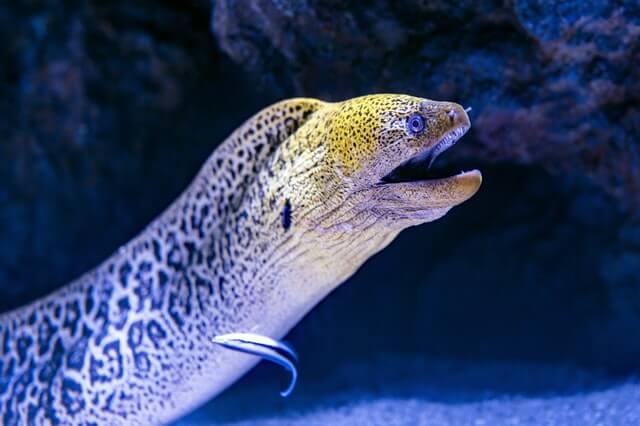
Electric eel or Electrophorus electricus is a popular species of fish known to give electric shocks. These electric shock abilities of an electric eel are due to their special organs that can generate electric charges of range up to 650 Watts! That’s five times the power supply usually supplied to an average home.
However, they don’t use their special skills for hunting purposes but to assist their weak eyesight for navigation purposes. If these facts seem interesting about this majestic animal electric eel, continue reading to find more amazing and unbelievable facts!
- Common name: Electric eel
- Scientific name: Electrophorus electricus
- Type: Fish
- Diet: Carnivore
- Group name: Swarm
- The average lifespan in the wild: 15 years
- Length: 6-8 feet
- Weight: 44 pounds
49 Electric Eel Facts For Kids
- Electric eels are South American freshwater fish found largely in the Amazon River basin.
- An electric eel is not the only electric shock-producing fish. There are well over 600 other types of fish capable of producing electricity.
- An electric eel doesn’t look like a common eel! It resembles a catfish.
- They can’t breathe underwater for long. Thus, they come to the surface to breathe atmospheric air every 10 minutes.
- Unlike other fishes, an electric eel can survive in both types of waters, salty & fresh.
- They can reach up to the height of 6-8 feet and weigh around 44 pounds.
- They are found in multiple colors. For example, an electric eel can be white, black, blue, purple, or grey in color.
- Being heavy carnivores, they feed on other fishes, amphibians, birds, and small mammals.
- They have gills; however, they are not as strong as those of other water animals.
- They possess very strong teeth that can rip apart their prey and keep the predators away.
- The male eel uses the spit from his mouth to create a nest for the female eel to lay her eggs in.
- A female electric eel can deposit up to 17000-18000 eggs at a time into her nest.
- Newly hatched electric eel babies feed on small invertebrates.
- Small or baby electric eels may also find their meal in the eggs of other electric eels or animals.
- Around 80% of the organs of an electric eel are believed to be capable of producing electricity.
- They can produce an electric shock of magnitude as high as 650 Watts. This much electric shock is enough to knock down an adult horse.
- Electric eels don’t produce shocks to prey. Instead, these electric shocks help them navigate through the water.
- Electric eels have poor eyesight from birth.
- An adult electric eel can live for up to 15 years in the wild and 22 years in captivity.
- Electric eels are not very aggressive in nature. They become aggressive upon sensing harm to them.
- Electric eels are nocturnal, i.e.; they are the most active during night hours than in the morning.
- They are mainly found in the muddy & dark waters of the Amazon.
- They also resemble knife fish. They are members of the Gymnotiformes order of bony fish.
- The undersides of an electric eel are usually orangish-red.
- It has two side fins (pectoral) and a long anal fin.
- The anal fin of an electric fish is on its underside, from the very head to the tip of its tail.
- The elongated anal fin of the electric eel helps it move back and forth inside the water with great force and motion.
- Female eels are always bigger than male eels in both size and weight.
- An electric eel doesn’t have lungs.
- It “gulps” air to survive.
- Some varieties of electric eels can also be found in freshwater lakes, streams, and small rivers.
- Electric eels can also eat fruits that accidentally fall into the water.
- An electric eel produces two types of charges – low voltage and high voltage. The former is used for finding a path at night, and the latter is used to knock down the prey.
- An electric can also detect colors through its electric charge. This is because different colors have different conductivities.
- The tail of an electric eel constitutes 7/8th of its entire body length. The main organs of an electric eel that produce electricity are housed in its tail.
- There are a total of three main electricity-producing organs in the entire body of an electric eel. The main organ is situated at the top end of the body, while Hunter’s organ is present at the bottom end.
- The third or Sach’s organ is present in the tail of the electric eel.
- Sach’s organ produces a low voltage current, while Hunter’s organ produces a high voltage current.
- The head of an electric eel resembles the positive end of the battery, and the tail resembles the negative end. Thus, an electric eel is also called a “living battery.”
- The electric eel wraps itself around the prey to increase the intensity of its electric charge.
- Bioelectrogenesis is the scientific term for living organisms like an electric eel known to produce an electric current.
- Although the electric current produced by an electric eel can kill small fishes and other animals, it’s still not enough to knock down humans. This is because the eel can produce 860 volts at 1A current for just two milliseconds.
- Electric eels can’t live in the deep sea.
- A full-grown electric eel develops around 6,000 high-voltage producing cells throughout its body length.
- Unlike other fishes, there are no scales on the body of an electric eel.
- It’s very rare for a human being to come in contact with an electric eel.
- The mating of male and female electric eels happens during the dry season.
- They are not fast in the water.
- They don’t reproduce at high speed.
Conclusion
You might have heard more about the electric shock-producing capabilities of an electric eel but wouldn’t have known that it’s not harmful to humans. Additionally, electric eels never emit high currents in the beginning. They will first emit low currents to scare their prey and then attack them by wrapping around its body.


